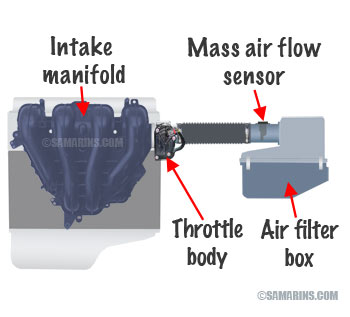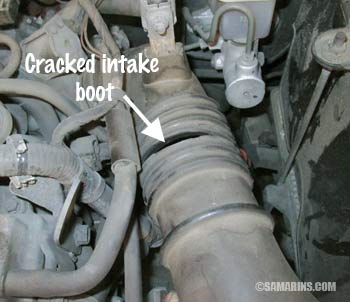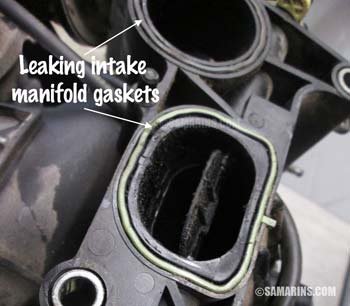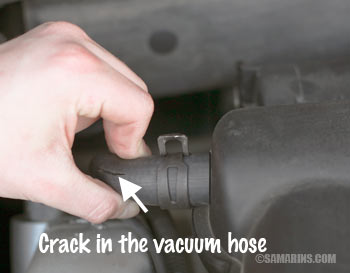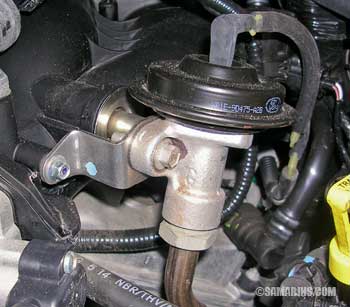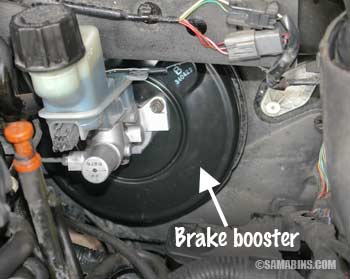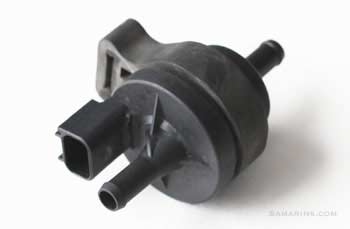Vacuum leaks: problems, symptoms, repairs
Updated: July 17, 2021
What is a vacuum leak? It's a leak anywhere between the engine and a mass air flow sensor. In most cars, a mass airflow sensor is installed at the air filter box, see the diagram.
In the fuel injection system, the mass air flow sensor measures the air flow into the engine.
The engine computer (PCM) calculates how much fuel to inject based on the mass air flow sensor measurements.If there is a vacuum leak anywhere between the engine and the mass air flow sensor, it causes "unmetered" air to enter the system. This causes the actual air flow to be higher than the mass air flow sensor measures. As a result, the PCM miscalculates the amount of the injected fuel, and the engine runs "lean". The term "lean" means too much air and too little fuel. The effect of a vacuum leak is more noticeable at idle, when the air flow is lower.
Vacuum leak symptoms
Symptoms of a vacuum leak include the Check Engine light, rough idle, stalling and a hissing sound coming from the engine bay. The engine may run well at higher RPMs, but surges, runs rough and struggles to maintain stable RPMs at idle. Often, the engine stalls when stopping. With a scan tool, one of the signs of a vacuum leak is the Long Term Fuel Trim (LTFT) going towards the plus (lean) side (e.g. over +15%) at idle, but returning close to zero at higher RPMs. This is an indication that the engine runs lean at idle.Common sources of vacuum leaks:
Intake snorkel: A rubber or plastic duct or boot (snorkel) that connects the engine intake and the air filter box can rip or crack. It's a very common problem in older and high-mileage cars. The repair is easy, the rubber boot must be replaced. In most cars, it's secured by worm gear clamps at both ends. The part costs from $25 to $65. If an intake boot is not installed properly at an air filter box (see this photo) or at a throttle body, it can cause a vacuum leak too.Intake manifolds and gaskets: An intake manifold is bolted to the engine head or plenum. With age, plastic intake manifolds warp. Gaskets and O-rings that seal the gaps harden and shrink. This causes vacuum leaks. This problem is very common in many cars, including Ford, Toyota, Chrysler and GM cars. Plastic intake manifolds are especially prone to leaks. Read more about the intake manifold.
To repair the problem, leaking gaskets and O-rings must be replaced. Gaskets and O-rings are cheap, but removing the intake manifold requires a lot of work. The repair costs $20-$60 for parts (gasket kit), plus $150-$450 labor.
In some cars, a plastic intake manifold can crack, or one of the fittings can break off. For example, intake manifold cracks were fairly common in some older Ford engines. In this case, an intake manifold must be replaced ($90-$320 part).
Plastic and rubber vacuum hoses and lines: With age, vacuum hoses become brittle and crack or rip. The hoses and lines that connect the PCV system to the intake manifold are especially prone to failures. This happens because crankcase vapors contain oil, that damages the rubber or plastic, causing hoses and lines to swell and crack. For example, the L-shaped rubber elbows that connect to the intake manifold were common to fail in some Ford/Mazda cars. The repair is to replace a cracked vacuum hose or line.
Positive Crankcase Ventilation or PCV system: The PCV system removes blow-by gases and oil vapors from the engine crankcase.
Advertisement
In many BMW, Volvo and other European models, the plastic and rubber parts of the PCV system crack and fall apart at higher mileage, creating vacuum leaks. In some GM cars, a PCV valve has a rubber diagram inside that is very common to fail. To repair the problem, failed parts must be replaced. Parts are not very expensive, but in many cars the components of the PCV system are installed under the intake manifold. Removing an intake manifold is a labor-intensive job.
EGR Valve: The EGR system directs a small amount of exhaust gases into the intake to lower the combustion temperature. The EGR Valve connects the intake manifold to the exhaust system. Normally, it opens only when the car is driven steadily at higher speeds. Often, however, an EGR valve sticks due to carbon buildup. If an EGR valve is stuck open, it creates a vacuum leak, with the only difference being that instead of air, it's the exhaust gases that enter the intake manifold.
A stuck-open EGR valve causes the same symptoms as vacuum leaks. Often, problems with an EGR valve that is stuck open are more noticeable after driving on the highway. For example, a car may stall when stopping after exiting the highway. A bad EGR valve must be replaced ($50-$320 part, plus $90-$320 labor). Read more: EGR valve: problems, symptoms, testing, replacement.
Brake booster: A brake booster is installed between the brake pedal and the brake master cylinder. In most cars, it's connected to the engine intake and is operated by the engine vacuum. Inside the brake booster, there is a vacuum diaphragm. When a brake booster leaks, it creates a vacuum leak. Symptoms of a leaking brake booster include a hissing noise coming from the brake pedal area and lack of brake assist.
A leaking brake booster is a safety concern and must be replaced. Several manufacturers have issued recalls or warranty extensions related to the brake booster. FCA (Chrysler) issued the recall R63 for some Dodge Dart models. There was also the recall P14 covering some 2011-2014 Dodge Durango and Jeep Grand Cherokee. Check for recalls at Safercar.gov. Several manufacturers offered warranty extensions. For example, Mazda offered Warranty Extension Program SSP 93 for the brake booster units in the 2007-2013 CX-9 models. Your local dealer can check for this type of information.
Diagnosing vacuum leaks is not always easy. Mechanics use a scan tool, special spray, a vacuum gauge and other testing equipment. Often, to find the source of a vacuum leak in the intake manifold, mechanics use a device called a smoke machine. A smoke machine produces vapor that looks like smoke. This vapor is introduced inside the intake manifold and a vacuum leak can be spotted visually by vapor coming out in the area of the leak. If no equipment is available, another way is to look for common problems in your Make, Model and Year. If your car has a vacuum leak, there is a good chance someone already had the same problem in the same car. Try, for example, searching YouTube or Google for 'Toyota Corolla 2005 common vacuum leak' and you will see people posting the repair information. In this car (Corolla), the intake manifold is the common source of vacuum leaks. We also found many YouTube videos on diagnosing vacuum leaks. Checking the technical service bulletins can also help. We posted a list of websites that offer paid access to factory service manuals for different cars at the bottom of this article.
